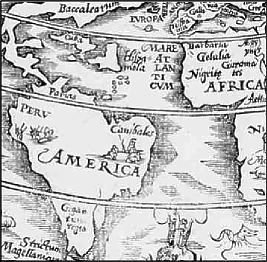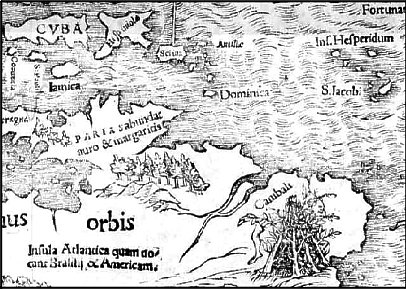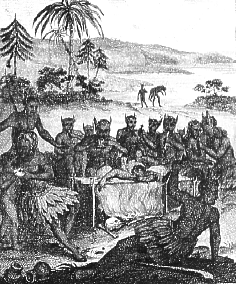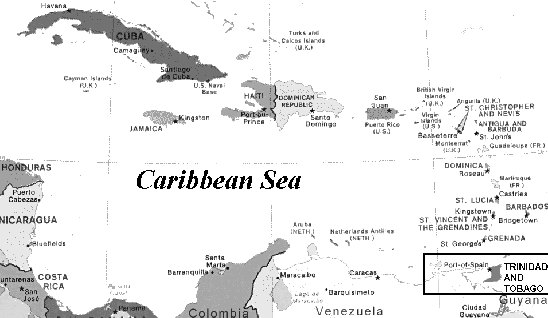|
OUTLINE FOR LECTURE #1 (Wednesday, 10 September, 2003):
Overheads for Week 3:
For more on Cannibalism in the Caribbean, see the Caribbean Amerindian Centrelink at: http://www.centrelink.org/Cannibals.htm
—Christopher Columbus (1493). “We knew that they were of a people called cannibals and that most of them live on human flesh; and of this you can be certain Your Magnificence….Of this we were certain in many parts, where we met such people, because we immediately saw bones and skulls of some they had eaten, and they do not deny it; moreover their enemies, who are always afraid of them, also say so….These people we knew to be cannibals and that they ate human flesh”. —Amérigo Vespucci, Letter to Lorenzo de Medici, of 18 July, 1500, on his landing in Trinidad. “the island of Trinidad…is populated by Carib Indians bearing arrows…. They are a very bellicose people, naked and idolatrous, and they eat human flesh, and beneath these vices one must believe that they have many others” — Gonzalo Fernandez de Oviedo y Valdés, 1530s
Handouts for Week 3:
HOW YOUR ESSAYS ARE JUDGED IN AN/S 336 In GENERAL, avoid the following:
...all of this will help explain how a student can lose 'points', but it doesn't help to explain the more positive aspects of how students can gain 'points'. That is the purpose of the following sections: Range of Judgments: There will usually be differences in the level of effectiveness ranging from: those that are simple and almost mechanical in their recitation of issues, to those that show some spark of intrigue, to those that write in a clearly advanced and sophisticated manner showing mastery of the subject and a profound sense of where the writer wants to take the reader. The degree to which students show a mastery of the concepts used, and the range of applications of concepts will be critical. Some will basically define a concept, then use a supporting passage from the readings--which is the most basic way of demonstrating conceptual ability. Others will move beyond this, develop insights of their own, and raise questions that either the readings and/or lectures failed to raise or to discuss adequately. Writing style is also critical: how effective are you at making clear statements? How far do you go to convince the reader that you actually understand what you are saying and what is being discussed? 1. INTRODUCTION:
2. MAIN BODY: > ensure that each of your paragraphs has a clear topic sentence to start it, i.e., "There are three separate approaches that focus on the relationships between anthropological knowledge and colonialism, each raising valuable questions, yet each suffering from shortcomings as well." > try to make the sequence of paragraphs match the sequence of themes and issues you laid out in the introduction > make clear use of reading materials, ideally in combination with class discussions and lectures, showing me that you are engaged in a 'dialogue' between yourself and your sources, as well as the dialogue between sources > always keep the main question(s) in mind, and write strategically and with purpose: ask yourself how what you are writing addresses those questions, what you are achieving with what you write, and where you are heading with your argument > carefully integrate supporting materials--a data dump, i.e. a simple quotation of an author's words to do your work or make your point for you is the most basic and very rudimentary way of bringing in supporting materials--the more advanced and effective way is to weave supporting materials into an integrated argument 3. CONCLUSION: > Use this space to concisely establish the key features of your argument, to 'wrap up' by condensing your argument into a set of key statements …AS A RESULT… Those that effectively do all of these things, while producing a paper that clearly manifests a deep degree of engagement with the material, will earn grades between 90% and 100%. Those that do most of these things, but with less of a thorough understanding of the issues, and lighter in the use of supporting evidence or other materials, will achieve a grade in relation to the papers above of roughly 80% to 90%. Those that do few of these things, or show an improper handling of concepts or little use of course materials (lectures, discussions, readings), will achieve a grade in the range of 70% to 80%. The 60% to 70% range is for those papers that show, very clearly, that some of the key concepts have not been understood, or are improperly applied, and that other of the above elements are missing in large part. Those that omit parts of the assigned question, retain many stylistic errors, show evidence of careless writing, or lack of understanding of the basic concepts used, will earn between 40% and 60%. Please note, given the comparative nature of the grading system, there are no precise amounts of points assigned for various components of a paper (i.e., how many readings are used, how well they are used, etc.). Therefore if one student receives 25 out of 30, and a paper that is close in quality receives 23 out of 30, I will not be able to pinpoint the precise point in your paper where you seem to have "lost" 2 points. In reality, those 2 points were never gained, and the grade is simply a reflection of a scale of quality: "it's almost as good as X's paper, but it lacks this or that element...so it cannot receive the same grade. On the other hand, it is superior to Y's paper (for some or all of the reasons outlined in the sections above)". Understand the method as well: points are earned as you build your paper further; failing to build beyond a certain point does not mean losing grades as much as it means not having gained them. Nobody starts out with 30 out of 30. As a rough guide, the best paper in a group is assigned a grade in the following manner (assume a paper worth 30 points): 1. 10 points for the amount of course materials used (lectures, discussions, films, readings), and for how well they are used (integrated into an argument, judicious selection of quotes, not a mere listing of quotes). 2. 10 points for analytical and conceptual clarity (the argument does not contradict itself repeatedly, the writer stays focused, concepts are defined, concepts are related to one another when applicable, pros and cons are considered, assertions are supported with evidence or logic) 3. 10 points for structure, logical organization, and effective writing Cannibalism, Colonialism and Anthropology
ETHNICITY 1. From “Tribes” to “Ethnic Groups” 2. From “Races” to “Ethnic Groups” 3. Defining Ethnicity à The Debate (Part One): ASCRIBED STATUS versus ACHIEVED STATUS 4. “It Takes Two to be Ethnic”: Ethnicity as a Relationship a. Relationship across a Boundary b. Group Identification and Categorization c. Objectivist versus Subjectivist Approaches to Ethnicity: 5. The Debate (Part Two):
|
|
Attachments Inheritance Unchanging Essence |
Process Strategy Shifting negotiation |
6. The “Problem” of Multi-Ethnic Nation-States:
A. PLURAL SOCIETY THESIS (J.S. Furnivall—South East Asia, M.G. Smith--Caribbean, Leo Kuper—South Africa)
B. CREOLE SOCIETY THESIS (R.T. Smith—Caribbean)
Overheads for Week 9:
World-Systems Analysis:
-
Critique of Modernization Theory
-
Centre and Periphery
-
"axial division of labour"
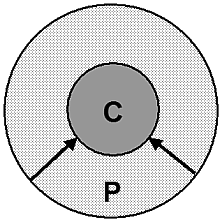
- Non-autonomy of nation-states
- Long-term & large scale
- Single capitalist economyàglobal
- ceaseless accumulation of capital
- CWEßàinterstate system
- Origins: 16th century
- Europe, incorporations
- Racism and sexism
- antisystemic movements
Wolf: Against the conventional concepts of Culture
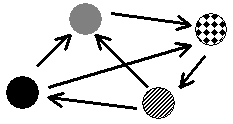
THE “INVENTION” OF TRADITION
- A. Nativistic Movements (Linton) à
- B. Revitalization Movements (Wallace)
Gaps in (A) & (B):
- 1. organisational form
- 2. how certain practices, rituals, objects or discourses come to be known as “traditions”
- 3. why such movements occur in a particular time-space
- 4. globalising forces
- 5. the larger, powerful, external institutions participating and vesting interests
- 6. analysis of cases that are not engaged in conflict, opposition, agitation or rebellion
C. Invention of Tradition (Hobsbawm)
‘Invented tradition’ is taken to mean a set of practices, normally governed by overtly or tacitly accepted rules and of ritual or symbolic nature, which seek to inculcate certain values and norms of behaviour by repetition, which automatically implies continuity with the past. In fact, where possible, they normally attempt to establish continuity with a suitable historic past (Hobsbawm 1983: 1).
D. Reinvention of Tradition (Handler & Linnekin)
Tradition is invented because it is necessarily reconstructed in the present, notwithstanding some participants’ understanding of such activities as being preservation rather than invention…. traditional action may refer to the past…to ‘be about’ or to refer to is a symbolic rather than natural relationship, and as such it is characterized by discontinuity as by continuity (Handler and Linnekin 1984: 279, 276).
Jackson: Revival = Reinvention
if a ritual evolves from something Tukanoans do entirely for one another to something they do for outsiders, or if Tukanoans perform a ritual for themselves because it fosters a self-image that has been inspired by outsiders, then despite superficial similarities between traditional rituals and these new ones, they are not traditional in some important aspects (Jackson 1989:132).
E. Inversion of Tradition (Thomas)
- Reformulation of tradition
- Articulation of tradition
- Objectification of tradition
- Inversion of tradition
F. Social Organization of Tradition (Antoun)
Reinterpretation of tradition:
“a universal process found among all societies at all times once particular hinterland communities become linked to overarching political, economic and religious structures and implicated in the concomitant processes of debt, politics, social control, and the quest for salvation”
Culture brokers:
culture brokers interpret a message “for a particular clientele...at the same time that they deal with political and religious hierarchies [amongst others] whose norms and aims [may] differ from those of both the culture broker and his audience”
- G. Critiques of Inventionism:
- (Friedman, A.D. Smith, Sahlins)
Inventions take root when authentic:
“experiential substrate”
Pre-existing elements legitimate inventions
Invention assumes authenticity
H. Is there a way out?
Construction versus Invention
Co-Production versus Invention
… an “interactionist” approach?
à but what’s the “real” problem?
Handout for Week 13--Case Study: Identity in Mashpee
|
|
History I
(defendants: New Seabury) |
History II
(plaintiffs: Mashpee Tribe) |
|
Summary of Arguments: |
There never had been an Indian tribe in Mashpee. The community was a creation of the colonial encounter. They were a collection of diverse Indians and other minorities from different areas. They became American citizens. They were assimilated into American society—decimated by disease, desiring freedom from state tutelage. Their Indian identity had been lost, over and over, since the mid-1800s. |
The residents of Mashpee, in the face
of sometimes daunting odds, had managed to keep alive a core of Indian
identity. They always attempted to control, not reject, outside forces, and
had managed change in often surreptitious ways, designed to promote their
integrity and continuity as a tribe. |
THE PLAGUE |
A plague had decimated the original inhabitants of the area by the 1620s. Led by a Christian convert, they were organized as “praying Indians” in a plantation, to protect them from white expansion. Thus Mashpee was itself an artificially created community, never a tribe. |
For aboriginals, the concept of “tribe” and one involving people fixed in one place, has no meaning. Communities formed and reformed continuously. Not all tribes were settled in one place, all of the time (remember nomadism?). Remember that many “bona fide”, federally recognized, Indian tribes developed tribal structures only in the late 1800s and early 1900s as a response to white expectations and power. The effect of the plague created an emergency, but was not as severe as in some areas, where there are recognized tribes. |
|
CONVERSION TO CHRISTIANITY |
“Praying Indians” gave up old ways; stopped powwows; altered child
rearing practices; dressed in new ways; washed differently; adopted the ways
of their more powerful adversary; willingly gave up old beliefs and acquired
a new faith. |
Cultural change is more complex than simple “wishful evangelism”.
Indian response to Christianity was syncretic, never just a simple either-or
response. Gain of Christian beliefs did not necessarily mean the loss of
Indian spirituality. Pastors were always Indian themselves. Services held in
Massachusett language. Christianized Indian leaders led revitalization
movements. Baptist Convention referred to Mashpee as “our Indian church”. |
“PLANTATION” STATUS |
Once plantation status acquired, their rights to land fell under
English laws of written deed, not aboriginal sovereignty. In 1870 became
incorporated as a “town”, as citizens of Mass., not as a sovereign
reservation. |
17th cent. English proprietary forms did not restrict
their ability to function as an Indian community. Merely a defensive
strategy, using available English laws to prevent further encroachments on
their land. Was a de facto reservation. |
|
TAKING THE COLONISTS’ SIDE |
Actively identified with the new society. Fought other Indians.
Fought in Revolutionary War against the English. Patriotic American citizens. |
Infighting amongst Indians does not prove abandonment of Indian
sovereignty. Mobilization with colonists done by a minority, maybe had little
choice. War against English served own interests, rebelling against English
missionaries. Survival in face of massive change. Being an American citizen
is not inconsistent with being fully Indian. |
INTERMARRIAGE |
Influx of Indians from other areas in late 1600s, again a century
later. By 1800s, “overrun with blacks and foreigners”. |
Indians were comparatively colour blind. Long history of
incorporating foreigners. Captives assimilated into Indian culture. Can trace
their kinship ties to names of actual Indians listed in census of 1859. |
|
MASHPEE BECOMES A TOWN |
1834, incorporated as a town; free voting citizens. |
Town was kept firmly in Indian hands, so this became a new way to
preserve old integrity. Besides, there was an internal split between
modernists and traditionalists, the former dominating the archival record and
getting more attention. |
|
ASSIMILATION |
Between 1905 and 1960, category of “Indian” disappeared from federal
census records for the area. Expressions of Indian culture are county
fair-like, folkloric. |
Assimilation is too linear to be realistic. Culture change is not
culture loss. Did best to preserve culture; often kept low profile. Keen to
regain old traditions shows active identification with the past. |
PLEASE NOTE: THIS WEBSITE CAN ONLY BE
VIEWED PROPERLY WHEN USING INTERNET EXPLORER 5+. In most other cases,
the site design may appear to be fractured.
This page was designed and created by
Maximilian C. Forte on Monday, 09 June, 2003.
Page last updated: Monday, 01 December, 2003.
